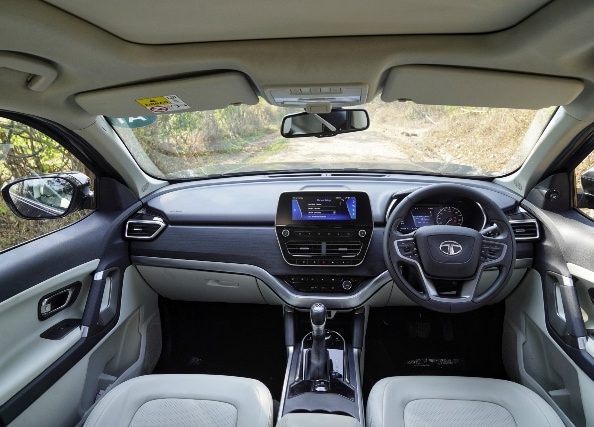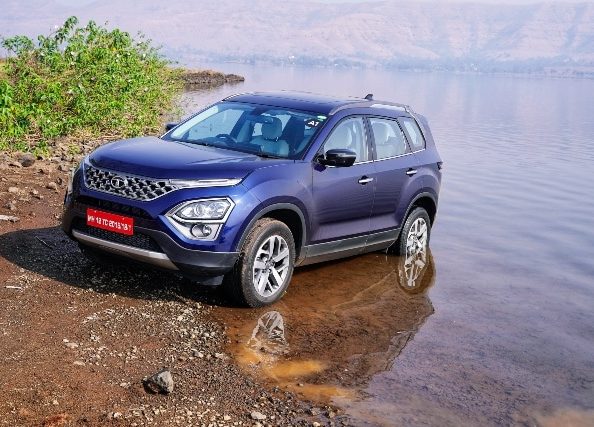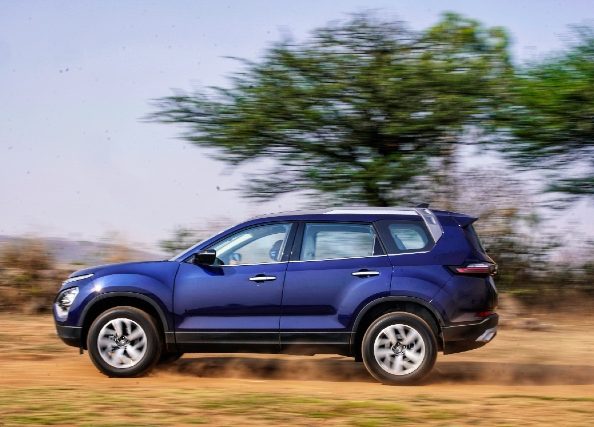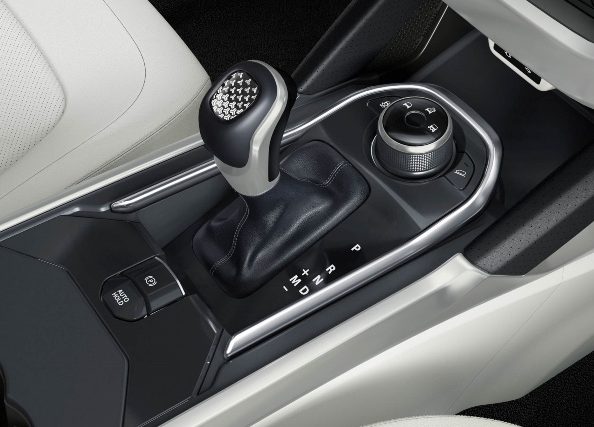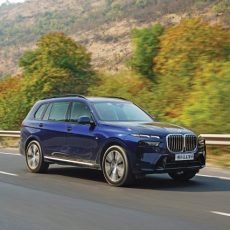We drive the Tata Safari diesel automatic variant before it is officially launched in India. Here’s all you need to know.
The 2021 Tata Safari is here and we’re super kicked to be among the first to get behind the wheels. But unlike the original Safari, this one doesn’t get a Ladder-on-Frame chassis but instead utilises a Monocoque frame. Moreover, it’s just front-wheel driven, at least for now. So, can the 2021 be a Safari? We drive to frond out.
Design
It looks very similar to the Tata Harrier, not surprisingly though, because both of them use the OMEGA platform which has been derived from Land Rover’s D8 platform. From the front till the C-pillar, there’s barely anything to set them apart, barring the new tri-arrow motif on the front grille of the Tata Safari.
It’s longer and even taller than the Harrier, but in terms of width and wheelbase the two SUVs are identical. And the side profile reveals this by the way the longer rear overhangs that have been stretched to accommodate the third row of seats. The stepped roof treatment is a reminiscence of the older Safari, while the chrome finished roof rails with the “Safari” etched on them is nice touch. Compared to the Harrier, it also gets a larger rear-quarter glass and a more straight forward rear section with a new tailgate and redesigned 3D-type LED tail-lamps. Adding to the robust character are a set of 18-inch machined alloys on the top variants.
The new Tata Safari isn’t as imposing as the older Safari Storme and it lacks that strong SUV character and towering road presence. This is in spite of the new Safari being longer, wider and having a larger wheelbase than its predecessor.

Cabin
As you get inside the cabin, you don’t get that commanding driving position, and like the Harrier it’s more crossover-like low seating. Having said that, the driver does get a six-way adjustable seat and can vary the lumbar support as well to comfort the lower back. The design is also similar to its sibling with a neat layout and multiple textures and material to keep things interesting.
A notable change is the black-and-beige interior with faux ash-wood highlights which give the cabin a touch more upmarket feel. The ambient lighting is a new feature here and thankfully Harrier’s aircraft-like handbrake has been replaced by a neat electronic one with auto-hold function. It’s a good looking cabin but there’s still scope for improvement in terms of ergonomics.
Captain Seats
This top-of-the-line six-seater variant gets two Captain seats in the middle row and a couple of seats right at the back. The new Oyster White leatherette upholstery makes the cabin look roomier, but light-coloured seats are not ideal for our country. Tata will also have a seven-seat option when they officially launch the new Safari. Meanwhile, the six-seater comes with a “Boss Mode” which essentially is a lever on the front passenger seat that can make it slide forward creating more room for the second row passenger. The seats are pretty comfortable and the cabin is spacious making it a great place to be in on long drives. (Also Read: MG Hector Plus Review)

Third Row Seats
Even the third row has a nice ergonomic design, and is decent enough to seat two adults. Compared to other cars at this price point, it’s pretty decent and leaves little to complain about. Short distance travelling won’t induce knee cramps, but for longer drives smaller individuals will be able to adjust to the limited room and under-thigh support. All three rows of seats get dedicated a-c vents, USB charging ports and cubbyholes, which is a nice touch. With all the seats in place, there’s just a meagre 73 litres of boot space, which can be increased to 447 litres by folding the third row.
Features
Our top-end XZ+ Tata Safari is well equipped and gets ESP, cruise control, six air-bags, rain sensing wipers, hill hold with hill descent, and, of course, a host of connected car technologies. There’s also a massive sunroof, a nice nine-speaker JBL audio system, a seven-inch digital instrument cluster for the driver which on the safari also gets tyre pressure monitor and a 8.8-inch touchscreen infotainment system with Apple carPlay and Android Auto. Over the Harrier the infotainment system gets more connected car features and now even understands Hinglish commands. Also, there are three drive modes — Eco, Sport, and City, along with three terrain modes — Normal, Wet, and Rough.
Engine
The new Tata Safari comes with a 2.0-litre Kryotec turbo-diesel engine as in the Harrier. It is also in the same state of tune as its smaller sibling as it produces 170 hp at 3,750 rpm and 350 Nm of torque between 1,750-2,500 rpm. You can pick either a six-speed manual or, like us, go for the six-speed torque convertor automatic gearbox. The auto ‘box takes the sting out of daily drives and also gets a manual mode but without paddle shifters.

Performance
As a city commuter, the Safari springs no unpleasant surprises. You can be light with the throttle inputs and it’ll get up to 60 km/h effortlessly and the gear changes are smooth and seamless. The throttle response isn’t lurchy and power delivery is pretty linear. We comfortably cruised at 120 km/h on the highway with the diesel mill purring away. Having said that, it doesn’t have that aggressive character one associates with large SUVs and lacks that brute nature. The Sport mode makes the response a tad more aggressive, but won’t give you goose-bumps.
Six-Speed Automatic Gearbox
The six-speed automatic torque converter is responsive enough to give you a downshift when desired but it isn’t supersonic fast. With two occupants in the car and some luggage it didn’t give us reason to complain but the drive isn’t engaging either. So for instance, regular overtaking doesn’t warrant planning as long as you give the transmission a few moments to downshift. But on ghats, it’s best to stick to manual mode as it holds on to a gear through steep climbs, making the drive smoother.
Ride and Handling
Our huge concern was the inconsistent steering, which lacked feedback and felt completely detached. On our test car, the steering was pretty heavy during low pace manoeuvres and became floaty at higher speeds. Tata promise that this will improve on the production cars. The suspension is set on the firmer side, but that’s probably to reduce body-roll. The ride is not really bumpy but occupants will feel the sharp road irregularities. Measuring 4.6 meters and weighing a good 1,825 kg you feel the size while driving inspite of clever electronics like Electronic Stability. Plus, having discs on all four ends ensures solid braking and you can shed speed rapidly. The only set-back is that the pedal feel is not progressive, so initially it offers nothing and then comes back with a sudden bite.
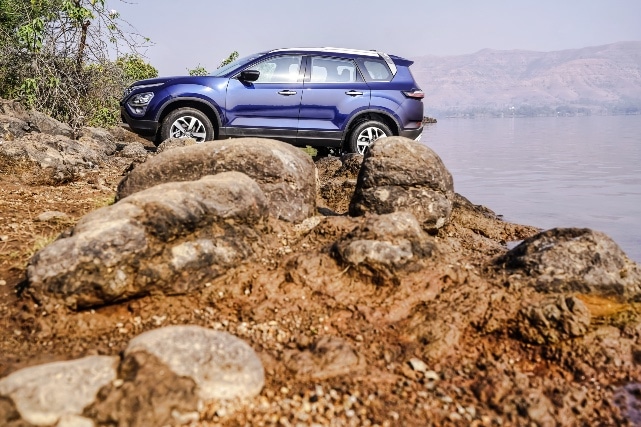
Off-Road
What impresses us is the poise this front-wheel-drive vehicle shows on crawling over broken roads that most namesake SUVs will find extremely difficult to match. The credit for this goes to the Land Rover derived OMEGARC underpinnings the new Safari is based on. Engage the “Rough” terrain mode and it calibrates the power delivery to imitate the “Low” drive mode seen on proper off-roaders. I really hope Tata Motors are working on a 4×4 model, because this platform has been designed to incorporate a four-wheel-drive system.
Price
The new Tata Safari is expected to be offered in some nine trim levels ranging between XE, XM, XMA, XT, XT+, XZ, XZA, XZ+, and XZA+. The prices will be revealed in mid-February and we expect it to be between Rs 15 lakh for the entry-level model to Rs 21.75 lakh for the top-of-the-line variant.



